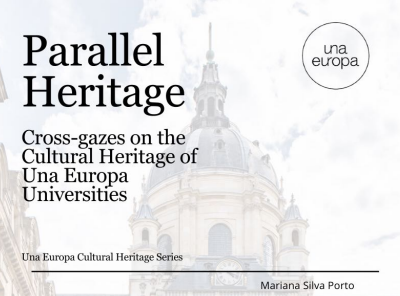
On September 2025, the second volume of the Una Europa Cultural Heritage Series was released: Parallel Heritage: Cross-gazes on the Cultural Heritage of Una Europa Universities, authored by Mariana Silva Porto.
This publication continues the work initiated with the first volume, Dissonant Heritage: Concepts, Critiques, Cases, and represents another important step in the actions promoted by the Cultural Heritage Self Steering Committees within the UnaFutura framework. The series aims to advance research and dissemination in the field of cultural heritage through open access and online publications accessible worldwide.
Parallel Heritage offers a comprehensive exploration of the heritage of Una Europa’s founding universities—Bologna, Paris 1 Panthéon-Sorbonne, Krakow, Madrid, Leuven, Edinburgh, Helsinki, and Berlin—highlighting both tangible and intangible elements that shape their identity.
Through six key categories—History of the university, Built Heritage, Museums and Collections, Ceremonies and Traditions, Management of University Collections, and Digital Heritage—the book provides an in-depth comparative overview of how academic institutions approach and value their cultural assets.
The research was developed in the framework of the “Parallel Heritage of European Universities” (PHOENIX) project and benefited from the collaboration of all Una Europa universities and their cultural partners. It offers not only detailed case studies but also a forward-looking reflection on how universities, as centuries-old institutions, contribute to broader discussions on European heritage and identity.
The volume stands out as a significant contribution to the ongoing effort to construct a shared Una Europa discourse on cultural heritage, serving both as a scholarly reference and as a tool for strengthening the role of universities in their local and international communities.
In line with Una Europa’s commitment to open access, Parallel Heritage is available online for free, ensuring that anyone, anywhere in the world, can access and benefit from this valuable resource.
You can access the publication through the following link: